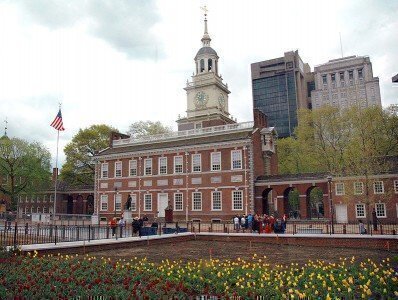Philadelphia was the early capital of the United States after the Constitution was ratified, but on May 14, 1800, the nation’s capital moved to Washington. Here's a look behind the deal that changed the face of American government.

The City of Brotherly Love became the ex-capital for several reasons, including a deal between Alexander Hamilton and Thomas Jefferson, and a compromise over slavery.
And some rowdy actions in 1783 by Continental soldiers in Philadelphia, and the reaction from the state militia, didn’t help arguments to keep the capital in Pennsylvania.
Until then, Philadelphia had been the hub of the new nation. Important decisions were made there, and it was equally accessible from the North and the South.
The Confederation Congress was meeting in Philadelphia in June 1783 at what we now call Independence Hall. However, there were serious problems afoot: The government had problems paying the soldiers who fought in the war against the British for their service.
The Pennsylvania Mutiny of 1783 was a crisis that literally forced the Congress to focus on its personal safety and pitted the federal government (in its weakened form) against the state of Pennsylvania.
Unpaid federal troops from Lancaster, Pennsylvania, marched to Philadelphia to meet with their brothers-in-arms. A group of about 400 soldiers then proceeded to Congress, blocked the doors to the building, and demanded their money. They also controlled some weapons-storage areas. James Madison noted that the soldiers were pointing muskets at the State House and appeared to be imbibing "spirituous drink."
Congress sent out one of its youngest delegates to negotiate with the troops: Alexander Hamilton, a former soldier himself. Hamilton convinced the soldiers to back down so Congress could meet quickly and reach a deal about repaying the troops.
Hamilton did meet with a small committee that night, and they sent a note to Pennsylvania’s state government asking for its state militia for protection from the federal troops. Representatives from Congress then met with John Dickinson, the head of Pennsylvania’s government; Dickinson discussed the matter with the militia, and the state told Congress it wouldn’t use the state’s troops to protect it.
That same day, Congress packed up and moved temporarily to Princeton, New Jersey. It traveled to various cities over the following years, including Trenton, New Jersey; Annapolis, Maryland; and New York City.
Delegates agreed to return to Philadelphia in 1787 to draw up the current U.S. Constitution, while the Congress of the Confederation was still seated in New York City.
Part of the new Constitution addressed the concerns caused by the Pennsylvania Mutiny of 1783.
Article I, Section 8 gave Congress the power to create a federal district to “become the Seat of the Government of the United States, and to exercise like Authority over all Places purchased by the Consent of the Legislature of the State in which the Same shall be, for the Erection of Forts, Magazines, Arsenals, dock-Yards, and other needful buildings."
When Congress met in 1789, two locations were proposed for the capital: one near Lancaster and another in Germantown, an area just outside Philadelphia.
However, Hamilton became part of a grand bargain to move the capital to an undeveloped area that encompassed parts of Virginia and Maryland, receiving some help from Thomas Jefferson along the way.
The Residence Act of 1790 put the capital in current-day Washington as part of plan to appease pro-slavery states who feared a northern capital as being too sympathetic to abolitionists. In turn, Hamilton received a commitment to reorganize the federal government’s finances by getting the southern states to indirectly pay off the war debts of the northern states.
A twist in the deal was negotiated by Robert Morris. Until the new capital was built on the Potomac, the capital would move back to Philadelphia for 10 years.
During the following decade, Philadelphians lobbied hard for the capital to stay in Pennsylvania. They offered President Washington an elaborate mansion as an incentive to stay. Instead, he and his successor, John Adams, lived in a more modest house near Congress.
A yellow fever epidemic hit Philadelphia in 1793, raising doubts about the safety of the area. And native Virginians like Washington, Madison, and Jefferson were actively planning for a capital near their home.
So one May day in 1800, Congress ended its business in Philadelphia and started the move to the new Federal District. President Adams also left Philadelphia in April and moved into the White House in November.







